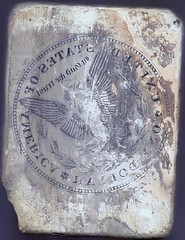
PREV ARTICLE
NEXT ARTICLE
FULL ISSUE
PREV FULL ISSUE
HAS EARLY ARTWORK FOR THE MORGAN DOLLAR BEEN FOUND? OTHERS THINK NOT The E-Sylum readers have spoken. My first impression was correct. The responses from our expert readers are unanimous - the Morgan Dollar-related item discussed last week is probably a lithography printing stone. -Editor Matt Hansen of Harrisburg, South Dakota writes:  Regarding your query in the most recent E-Sylum about "HAS EARLY ARTWORK FOR THE MORGAN DOLLAR BEEN FOUND?", the object in question appears to be a lithographic printing stone. Lithographic stones were typically a very fine-grained limestone (often from Bavaria) onto which a reverse image of the subject to be printed would be transferred using a waxy ink. These were commonly used in the 1800s Additional information on the process of stone lithography can be found at: How Stone Lithography Works (www.howstuffworks.com/stone-lithography.htm) Regarding your query in the most recent E-Sylum about "HAS EARLY ARTWORK FOR THE MORGAN DOLLAR BEEN FOUND?", the object in question appears to be a lithographic printing stone. Lithographic stones were typically a very fine-grained limestone (often from Bavaria) onto which a reverse image of the subject to be printed would be transferred using a waxy ink. These were commonly used in the 1800s Additional information on the process of stone lithography can be found at: How Stone Lithography Works (www.howstuffworks.com/stone-lithography.htm)My guess is that the piece was created by a printer at newspaper or magazine or order to reproduce an image of the coin. This printing technique was in widespread use at the time the Morgan dollars first came out in 1878, so maybe it was someone wishing to illustrate the new coin design in some publication. We'll probably never know for sure. George Cuhaj writes: The large Morgan Dollar item is a lithography stone, used in the printing process. Something this size might have been used for a poster. It would still have crop marks for centering and trim. Tom DeLorey agrees. He writes: It appears to me to be a lithographic stone, and when I showed the image to Dennis Forgue he agreed with me. Bill Eckberg writes: The item is almost certainly a lithographic stone. The color, thickness, cracks, etc., all look like a litho stone and not like plaster or anything else. The enlarged image appears to show pretty clearly that the image is engraved into the surface. This was a common method for printing stock certificates, bank documents and the like back in the 19th and early 20th century. If it is a litho stone, it would have nothing to do with the production of the actual coin. I have never actually seen how one of these engraved stones was used, but I presume it was printed like an etching or engraving on a metal plate in that ink was squeezed into the lines and transferred to wet paper, much the way our paper money is still printed. Red Book editor Ken Bressett writes: While it is difficult to make an assumption based only on a picture, I am pretty sure the "strange object" questioned by Mr. Matzke this week is an old lithographic printing stone. It would have produced a large picture of a Morgan dollar, probably anywhere around 1878-1925. These stones are rather common, although I have never seen one showing a coin in such a large size. Perhaps it was made to print a picture of the Morgan dollar when it was new and novel. THE BOOK BAZARREWayne Homren, Editor The Numismatic Bibliomania Society is a non-profit organization promoting numismatic literature. See our web site at coinbooks.org. To submit items for publication in The E-Sylum, write to the Editor at this address: whomren@gmail.com To subscribe go to: https://my.binhost.com/lists/listinfo/esylum All Rights Reserved. NBS Home Page Contact the NBS webmaster 
|